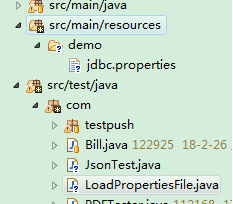java載入properties檔案的幾種方式
阿新 • • 發佈:2018-12-21
package com; import java.io.BufferedInputStream; import java.io.File; import java.io.FileInputStream; import java.io.FileNotFoundException; import java.io.IOException; import java.io.InputStream; import java.io.InputStreamReader; import java.util.Properties; import java.util.PropertyResourceBundle; import java.util.ResourceBundle; public class LoadPropertiesFile { private static final String DEFAULT_ENCODING = "UTF-8"; /** * 使用java.util.Properties類的load()方法載入properties檔案 */ private static void Method1() { try { // 獲取檔案流(方法1或2均可) InputStream inputStream = new BufferedInputStream( new FileInputStream( new File("src/main/resources/demo/jdbc.properties") )); //方法1 // InputStream inputStream = Thread.currentThread() // .getContextClassLoader() // .getResourceAsStream("jdbc.properties"); //方法2 Properties prop = new Properties(); prop.load(new InputStreamReader(inputStream, DEFAULT_ENCODING)); //載入格式化後的流 String driverClassName = prop.getProperty("driverClassName"); System.out.println("Method1: " + driverClassName); } catch (FileNotFoundException e) { System.out.println("properties檔案路徑有誤!"); e.printStackTrace(); } catch (IOException e) { e.printStackTrace(); } } /** * 使用class變數的getResourceAsStream()方法 * 注意:getResourceAsStream()方法的引數路徑/包路徑+properties檔名+.字尾 */ public static void Method2() { try { InputStream inputStream = LoadPropertiesFile.class.getResourceAsStream("/demo/jdbc.properties"); Properties prop = new Properties(); prop.load(inputStream); String driverClassName = prop.getProperty("driverClassName"); System.out.println("Method2: " + driverClassName); } catch (IOException e) { e.printStackTrace(); } } /** * 使用class.getClassLoader()所得到的java.lang.ClassLoader的getResourceAsStream()方法 * 注意:getResourceAsStream(name)方法的引數必須是包路徑+檔名+.字尾 */ public static void Method3() { try { InputStream inputStream = LoadPropertiesFile.class.getClassLoader().getResourceAsStream("demo/jdbc.properties"); Properties prop = new Properties(); prop.load(inputStream); String driverClassName = prop.getProperty("driverClassName"); System.out.println("Method3: " + driverClassName); } catch (IOException e) { e.printStackTrace(); } } /** * 使用java.lang.ClassLoader類的getSystemResourceAsStream()靜態方法 * getSystemResourceAsStream()方法的引數必須是包路徑+檔名+.字尾 */ public static void Method4() { try { InputStream inputStream = ClassLoader.getSystemResourceAsStream("demo/jdbc.properties"); Properties prop = new Properties(); prop.load(inputStream); String driverClassName = prop.getProperty("driverClassName"); System.out.println("Method4: " + driverClassName); } catch (IOException e) { e.printStackTrace(); } } /** * 使用java.util.ResourceBundle類的getBundle()方法 * 注意:注意:這個getBundle()方法的引數相對同目錄路徑,並去掉.properties字尾,否則將拋異常 */ public static void Method5() { ResourceBundle resource = ResourceBundle.getBundle("demo"); String driverClassName = resource.getString("driverClassName"); System.out.println("Method5: " + driverClassName); } /** * 使用java.util.PropertyResourceBundle類的建構函式 */ public static void Method6(){ ResourceBundle resource; try { InputStream inputStream = new BufferedInputStream(new FileInputStream(new File("src/main/resources/demo/jdbc.properties"))); resource = new PropertyResourceBundle(inputStream); String driverClassName = resource.getString("driverClassName"); System.out.println("Method6: " + driverClassName); } catch (FileNotFoundException e) { e.printStackTrace(); } catch (IOException e) { e.printStackTrace(); } } public static void main(String[] args) { Method1(); Method2(); Method3(); Method4(); Method5(); Method6(); } }
5,6是通過ResourceBundle類來載入Properties檔案,然後ResourceBundle物件來操做properties檔案內容;
其中最重要的就是每種方式載入檔案時,檔案的路徑一定要對。
properties檔案以及專案結:
| 1 2 3 4 5 |
|

1:帶類載入器:
this.getClass().getClassLoader().getResourceAsStream("testVariables.bpmn") 從classpath根目錄下載入指定名稱的檔案
this.getClass().getResourceAsStream("testVariables.bpmn") 從當前包下載入指定名稱的檔案
this.getClass().getResourceAsStream("/testVariables.bpmn") 從classpath根目錄下載入指定名稱的檔案
